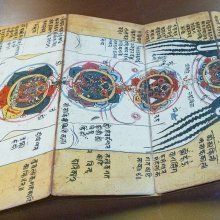Unconscious: 1 definition
Introduction:
Unconscious means something in the history of ancient India. If you want to know the exact meaning, history, etymology or English translation of this term then check out the descriptions on this page. Add your comment or reference to a book if you want to contribute to this summary article.
Images (photo gallery)
India history and geography
Source: Singhi Jain Series: Ratnaprabha-suri’s Kuvalayamala-katha (history)Becoming Unconscious (in a swoon) represents a scene of human life commonly depicted on the Saṃsāracakra paintings, in ancient India, as mentioned in the Kathās (narrative poems) such as Uddyotanasūri in his 8th-century Kuvalayamālā (a Prakrit Campū, similar to Kāvya poetry).—Page 185.21 f.: Here follows a description of a printed scroll illustrating the Jaina conception of saṃsāracakra. [...] The saṃsāra-cakra illustrated the three worlds of hell, human world and the world of gods. [For example:] The devoted wife crying and weeping for her departed lover, the old father sitting nearby with tears flowing from eyes and his mother becoming unconscious in a swoon.

The history of India traces the identification of countries, villages, towns and other regions of India, as well as mythology, zoology, royal dynasties, rulers, tribes, local festivities and traditions and regional languages. Ancient India enjoyed religious freedom and encourages the path of Dharma, a concept common to Buddhism, Hinduism, and Jainism.
See also (Relevant definitions)
Starts with: Unconscious Beings.
Full-text (+343): Pramugdha, Acetana, Nihsamjna, Visamjna, Nishcetana, Vicetana, Vimudhasamjna, Asanna, Amatipurva, Murcchita, Vibuddha, Vishanna, Nissamjna, Asanni, Visanni, Asannabhava, Visamjnita, Nashtasamjna, Abhavayant, Gaphalata.
Relevant text
Search found 197 books and stories containing Unconscious; (plurals include: Unconsciouses). You can also click to the full overview containing English textual excerpts. Below are direct links for the most relevant articles:
Vinaya Pitaka (4): Parivara (by I. B. Horner)
Origin (Sekhiya) < [18. Origin]
As To Graduation (4. Tetrads) < [7. As To Graduation]
The Tattvasangraha [with commentary] (by Ganganatha Jha)
Verse 2322-2324 < [Chapter 24a - The case for the reliability of the Veda (the Revealed Word)]
Verse 2021 < [Chapter 23 - External World]
Verse 2000 < [Chapter 23 - External World]
Yoga-sutras (with Bhoja’s Rajamartanda) (by Rajendralala Mitra)
Sūtra 1.18 < [First Chapter (Samadhi Pada)]
Sūtra 4.23 < [Fourth Chapter (Samadhi Pada)]
Sūtra 4.17 < [Fourth Chapter (Samadhi Pada)]
Brahma Sutras (Ramanuja) (by George Thibaut)
Sutra 4.4.16 < [Fourth Adhyaya, Fourth Pada]
Sutra 1.3.43 < [First Adhyaya, Third Pada]
The Great Purvapaksha < [First Adhyaya, First Pada]
Brihad Bhagavatamrita (commentary) (by Śrī Śrīmad Bhaktivedānta Nārāyana Gosvāmī Mahārāja)
Verse 2.1.122 < [Chapter 1 - Vairāgya (renunciation)]
Verse 2.3.3 < [Chapter 3 - Bhajana (loving service)]
Verse 2.4.258 < [Chapter 4 - Vaikuṇṭha (the spiritual world)]
Garga Samhita (English) (by Danavir Goswami)
Verse 2.5.5 < [Chapter 5 - The Liberation of Bakāsura]
Verse 5.2.11 < [Chapter 2 - The Killing of Keśī]
Verse 1.6.29 < [Chapter 6 - Description of Kaṃsa’s Strength]
